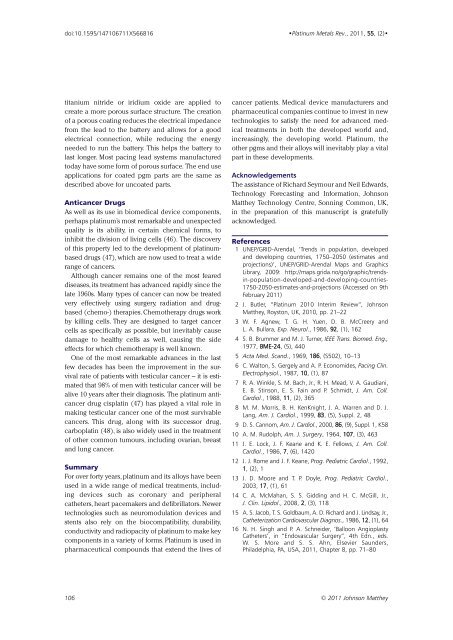Download - Platinum Metals Review
Download - Platinum Metals Review
Download - Platinum Metals Review
You also want an ePaper? Increase the reach of your titles
YUMPU automatically turns print PDFs into web optimized ePapers that Google loves.
doi:10.1595/147106711X566816<br />
•<strong>Platinum</strong> <strong>Metals</strong> Rev., 2011, 55, (2)•<br />
titanium nitride or iridium oxide are applied to<br />
create a more porous surface structure. The creation<br />
of a porous coating reduces the electrical impedance<br />
from the lead to the battery and allows for a good<br />
electrical connection, while reducing the energy<br />
needed to run the battery. This helps the battery to<br />
last longer. Most pacing lead systems manufactured<br />
today have some form of porous surface. The end use<br />
applications for coated pgm parts are the same as<br />
described above for uncoated parts.<br />
Anticancer Drugs<br />
As well as its use in biomedical device components,<br />
perhaps platinum’s most remarkable and unexpected<br />
quality is its ability, in certain chemical forms, to<br />
inhibit the division of living cells (46). The discovery<br />
of this property led to the development of platinumbased<br />
drugs (47), which are now used to treat a wide<br />
range of cancers.<br />
Although cancer remains one of the most feared<br />
diseases, its treatment has advanced rapidly since the<br />
late 1960s. Many types of cancer can now be treated<br />
very effectively using surgery, radiation and drugbased<br />
(chemo-) therapies. Chemotherapy drugs work<br />
by killing cells. They are designed to target cancer<br />
cells as specifically as possible, but inevitably cause<br />
damage to healthy cells as well, causing the side<br />
effects for which chemotherapy is well known.<br />
One of the most remarkable advances in the last<br />
few decades has been the improvement in the survival<br />
rate of patients with testicular cancer – it is estimated<br />
that 98% of men with testicular cancer will be<br />
alive 10 years after their diagnosis. The platinum anticancer<br />
drug cisplatin (47) has played a vital role in<br />
making testicular cancer one of the most survivable<br />
cancers. This drug, along with its successor drug,<br />
carboplatin (48), is also widely used in the treatment<br />
of other common tumours, including ovarian, breast<br />
and lung cancer.<br />
Summary<br />
For over forty years, platinum and its alloys have been<br />
used in a wide range of medical treatments, including<br />
devices such as coronary and peripheral<br />
catheters, heart pacemakers and defibrillators. Newer<br />
technologies such as neuromodulation devices and<br />
stents also rely on the biocompatibility, durability,<br />
conductivity and radiopacity of platinum to make key<br />
components in a variety of forms. <strong>Platinum</strong> is used in<br />
pharmaceutical compounds that extend the lives of<br />
cancer patients. Medical device manufacturers and<br />
pharmaceutical companies continue to invest in new<br />
technologies to satisfy the need for advanced medical<br />
treatments in both the developed world and,<br />
increasingly, the developing world. <strong>Platinum</strong>, the<br />
other pgms and their alloys will inevitably play a vital<br />
part in these developments.<br />
Acknowledgements<br />
The assistance of Richard Seymour and Neil Edwards,<br />
Technology Forecasting and Information, Johnson<br />
Matthey Technology Centre, Sonning Common, UK,<br />
in the preparation of this manuscript is gratefully<br />
acknowledged.<br />
References<br />
1 UNEP/GRID-Arendal, ‘Trends in population, developed<br />
and developing countries, 1750–2050 (estimates and<br />
projections)’, UNEP/GRID-Arendal Maps and Graphics<br />
Library, 2009: http://maps.grida.no/go/graphic/trends-<br />
in-population-developed-and-developing-countries-<br />
1750-2050-estimates-and-projections (Accessed on 9th<br />
February 2011)<br />
2 J. Butler, “<strong>Platinum</strong> 2010 Interim <strong>Review</strong>”, Johnson<br />
Matthey, Royston, UK, 2010, pp. 21–22<br />
3 W. F. Agnew, T. G. H. Yuen, D. B. McCreery and<br />
L. A. Bullara, Exp. Neurol., 1986, 92, (1), 162<br />
4 S. B. Brummer and M. J. Turner, IEEE Trans. Biomed. Eng.,<br />
1977, BME-24, (5), 440<br />
5 Acta Med. Scand., 1969, 186, (S502), 10–13<br />
6 C. Walton, S. Gergely and A. P. Economides, Pacing Clin.<br />
Electrophysiol., 1987, 10, (1), 87<br />
7 R. A. Winkle, S. M. Bach, Jr., R. H. Mead, V. A. Gaudiani,<br />
E. B. Stinson, E. S. Fain and P. Schmidt, J. Am. Coll.<br />
Cardiol., 1988, 11, (2), 365<br />
8 M. M. Morris, B. H. KenKnight, J. A. Warren and D. J.<br />
Lang, Am. J. Cardiol., 1999, 83, (5), Suppl. 2, 48<br />
9 D. S. Cannom, Am. J. Cardiol., 2000, 86, (9), Suppl. 1, K58<br />
10 A. M. Rudolph, Am. J. Surgery, 1964, 107, (3), 463<br />
11 J. E. Lock, J. F. Keane and K. E. Fellows, J. Am. Coll.<br />
Cardiol., 1986, 7, (6), 1420<br />
12 J. J. Rome and J. F. Keane, Prog. Pediatric Cardiol., 1992,<br />
1, (2), 1<br />
13 J. D. Moore and T. P. Doyle, Prog. Pediatric Cardiol.,<br />
2003, 17, (1), 61<br />
14 C. A. McMahan, S. S. Gidding and H. C. McGill, Jr.,<br />
J. Clin. Lipidol., 2008, 2, (3), 118<br />
15 A. S. Jacob, T. S. Goldbaum, A. D. Richard and J. Lindsay, Jr.,<br />
Catheterization Cardiovascular Diagnos., 1986, 12, (1), 64<br />
16 N. H. Singh and P. A. Schneider, ‘Balloon Angioplasty<br />
Catheters’, in “Endovascular Surgery”, 4th Edn., eds.<br />
W. S. More and S. S. Ahn, Elsevier Saunders,<br />
Philadelphia, PA, USA, 2011, Chapter 8, pp. 71–80<br />
106 © 2011 Johnson Matthey
















